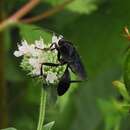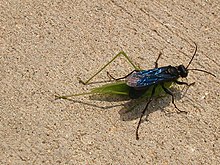pt-BR
nomes no trilho de navegação


Sphex pensylvanicus, the great black wasp, is a species of digger wasp.[3] It lives across most of North America and grows to a size of 20–35 mm (0.8–1.4 in). The larvae feed on living insects that the females paralyze and carry to the underground nest.
S. pensylvanicus is distributed across most of the contiguous United States and northern Mexico.[3] During the late 20th century, its range expanded north to New York[4] and the Canadian provinces of Quebec and Ontario.[5]
Sphex pensylvanicus is a large, black wasp, significantly larger than their congener Sphex ichneumoneus (the great golden digger wasp).[6] Males are smaller than females, at only 19–28 mm (0.7–1.1 in) long compared with typical female sizes of 25–34 mm (1.0–1.3 in).[2] According to John Bartram, "The sting of this Wasp is painful, but does not swell like others".[7] As well as being larger than S. ichneumoneus, they are also darker, with smoky wings and an entirely black body, where S. ichneumoneus has yellow wings, red legs, and a partly red abdomen.[8]

Adult females of S. pensylvanicus build an underground nest which they provision with various orthopteran insects,[9] particularly of the genera Microcentrum, Amblycorypha and Scudderia.[6] Prey are stung three times, once in the neck and twice in the thorax, and are paralyzed by the wasp's sting, although they can survive for weeks.[2] The prey are then carried to the nest. While collecting their prey, the females are vulnerable to kleptoparasitism, in which birds, including the house sparrow (Passer domesticus) and the grey catbird (Dumetella carolinensis), steal the prey that the wasp has collected.[9]
The eggs of S. pensylvanicus are 5–6 mm (0.20–0.24 in) long and 1 mm (0.04 in) wide; they are glued to the underside of the prey insect between the first and second pairs of legs.[2] Each of the several chambers in the nest houses a single larva, which consumes 2–6 katydids or grasshoppers.[9] The larval stage lasts 10 days, reaching a pre-pupation size of 30–35 mm (1.2–1.4 in) long by 7–10 mm (0.28–0.39 in) wide.[2]
S. pensylvanicus is an important pollinator of plants including the milkweeds Asclepias syriaca and A. incarnata.[10] It has also been reported on Daucus carota, Eryngium yuccifolium, Melilotus albus,[11] Monarda punctata , and Pycnanthemum virginianum[12] S. pensylvanicus is one of several species of Sphex to be parasitized by the strepsipteran Paraxenos westwoodi.[13]
Sphex pensylvanicus was the subject of the first article on an insect written by a native of the New World,[2][14] when observations made by John Bartram on S. pensylvanicus were presented to the Royal Society in 1749 by Peter Collinson.[7] Sphex pensylvanicus was described by Carl Linnaeus in his 1763 work Centuria Insectorum, using material sent to him by Charles De Geer.[15]
Sphex pensylvanicus, the great black wasp, is a species of digger wasp. It lives across most of North America and grows to a size of 20–35 mm (0.8–1.4 in). The larvae feed on living insects that the females paralyze and carry to the underground nest.
Sphex pensylvanicus (en anglais : great black wasp, litt. grande guêpe noire), est une espèce de guêpes fouisseuses du genre Sphex[3]. Elle vit dans la majeure partie de l'Amérique du Nord et atteint une taille de 20 à 35 mm. Ses larves se nourrissent d'insectes vivants que les femelles paralysent et transportent jusqu'à leur nid souterrain.
S. pensylvanicus est présent dans la plupart des États-Unis contigus et dans le nord du Mexique[3]. À la fin du XXe siècle, son aire de répartition s'est étendue au nord jusqu'à l'État de New York et aux provinces canadiennes du Québec et de l'Ontario[réf. souhaitée].
Sphex pensylvanicus est une grande guêpe noire, nettement plus grosse que sa congénère Sphex ichneumoneus (le grande sphex doré)[4]. Les mâles sont plus petits que les femelles, avec seulement 19-28 mm de long, contre 25-34 mm pour une femelle typique[2]. Selon le botaniste John Bartram, « La piqûre de cette guêpe est douloureuse, mais ne gonfle pas comme celle des autres[5]. ». En plus d'être plus grandes que S. ichneumoneus, elles sont également plus foncées, avec des ailes fumées et un corps entièrement noir, là où S. ichneumoneus a des ailes jaunes, des pattes rouges et un abdomen en partie rouge[6].
Les femelles adultes de S. pensylvanicus construisent un nid souterrain qu'elles approvisionnent en divers insectes orthoptères[7], en particulier des genres Microcentrum (en), Amblycorypha (en) et Scudderia (en)[4]. Les proies sont piquées trois fois, une fois dans le cou et deux fois dans le thorax, ce qui les paralyse, bien qu'elles puissent survivre pendant des semaines[2]. Elles sont ensuite transportées jusqu'au nid. Durant le ramassage de leurs proies, les femelles sont vulnérables au cleptoparasitisme des oiseaux, notamment du moineau domestique (Passer domesticus) et du moqueur chat (Dumetella carolinensis ), qui volent les proies que la guêpe a capturées[7].
Les œufs de S. pensylvanicus sont longs de 5 à 6 mm et larges d'1 mm ; la femelle les colle en-dessous de l'insecte proie, entre ses les première et deuxième paires de pattes[2]. Chacune des chambres du nid abrite une seule larve, qui consomme entre 2 et 6 sauterelles ou sauteriaux[7]. Le stade larvaire dure 10 jours ; la larve atteint 30 à 35 mm de long et 7 à 10 mm de large au moment de sa nymphose[2].
S. pensylvanicus est un important pollinisateur de plantes, notamment des asclépiades Asclepias syriaca et A. incarnata[8]. Il a également été signalé sur Daucus carota, sur le Panicaut à feuilles de yucca, le Mélilot blanc[9], la Monarde ponctuée et Pycnanthemum virginianum[10].
S. pensylvanicus est l'une des nombreuses espèces de Sphex parasitées par le strepsiptère Paraxenos westwoodi[11].
Sphex pensylvanicus a fait l'objet du premier article sur un insecte écrit par un natif du Nouveau Monde[2],[12] lorsque les observations faites par le botaniste John Bartram à son sujet ont été présentées à la Royal Society en 1749 par Peter Collinson[5]. Sphex pensylvanicus a ensuite été décrit par Linné dans son ouvrage de 1763 Centuria insectorum, en utilisant le matériel qui lui avait été envoyé par Charles de Geer[13].
Sphex pensylvanicus (en anglais : great black wasp, litt. grande guêpe noire), est une espèce de guêpes fouisseuses du genre Sphex. Elle vit dans la majeure partie de l'Amérique du Nord et atteint une taille de 20 à 35 mm. Ses larves se nourrissent d'insectes vivants que les femelles paralysent et transportent jusqu'à leur nid souterrain.
Sphex pensylvanicus là một loài côn trùng cánh màng trong họ Sphecidae, thuộc chi Sphex. Loài này được Linnaeus mô tả khoa học đầu tiên năm 1763.[2]
Sphex pensylvanicus là một loài côn trùng cánh màng trong họ Sphecidae, thuộc chi Sphex. Loài này được Linnaeus mô tả khoa học đầu tiên năm 1763.